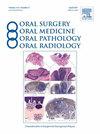Bond Strength between CAD/CAM PMMA Denture Base Resins and Characterisation Composites
Oral surgery, oral medicine, oral pathology, oral radiology, and endodontics
Pub Date : 2022-02-18
DOI:10.3390/oral2010009
引用次数: 2
Abstract
Aim: To measure the bond strength between two different CAD/CAM PMMA denture base resins and three different types of gum characterisation composites. Materials and Methods: CAD/CAM single cross-linked (Telio CAD) and double cross-linked (Vivodent CAD) resins were prepared, obtaining a total of 180 bar specimens. Each specimen was prepared according to the manufacturer’s instructions. The specimens were bonded to three different characterisation composites with varying viscosities; Kulzer Pala-creactive (P), Ivoclar SR Nexco (S), Shofu Ceramage (F). All the specimens were then tested using a chevron-notched three-point bond strength test in a universal testing machine to obtain fracture energy release toughness (MPa√m) and bond strength (MPa). The specimens were thermocycled to simulate 6 and 12 months of ageing in vivo. The results were statistically analysed (SPSS). The fractured surfaces of the tested specimens were examined with a scanning electron microscope (SEM) to evaluate the failure modes. Results: Pala-creactive characterisation composites showed the highest overall bond strength (3.49 ± 0.86 MPa) and fracture toughness (1.59 ± 0.34 MPa√m) when bonded to both CAD PMMA denture resins, which were statistically higher than the values obtained when they were bonded to Telio (p < 0.001). The Ceramage composite showed the lowest bond strength (1.05 ± 0.59 MPa) and fracture toughness (0.47 ± 0.4 MPa√m). The dominant mode of failure for all groups was mixed. Conclusion: Single cross-linked PMMA (Telio) showed a higher overall bond strength compared to double cross-linked PMMA when bonded to three different characterisation composites. Telio CAD showed a clear bond strength decrease after 6 and 12 months of artificial ageing, while Vivodent CAD showed a bond strength increase.CAD/CAM PMMA义齿基托树脂与表征复合材料的结合强度
目的:测定两种不同CAD/CAM PMMA义齿基托树脂与三种不同牙龈表征复合材料之间的粘结强度。材料与方法:制备CAD/CAM单交联(Telio CAD)和双交联(Vivodent CAD)树脂,共获得180 bar样品。每个样品都是根据制造商的说明制备的。将样品粘接到三种不同粘度的不同表征复合材料上;Kulzer Pala-creactive (P), Ivoclar SR Nexco (S), Shofu Ceramage (F)。然后在万能试验机上对所有试样进行v形缺口三点粘结强度试验,获得断裂能释放韧性(MPa√m)和粘结强度(MPa)。这些标本被热循环以模拟6个月和12个月的体内老化。用SPSS软件对结果进行统计分析。利用扫描电子显微镜(SEM)对试件的断裂面进行了分析,以评价试件的破坏模式。结果:两种CAD PMMA义齿树脂黏合Pala-creactive表征复合材料的总黏合强度(3.49±0.86 MPa)和断裂韧性(1.59±0.34 MPa / m)均高于与Telio树脂黏合时(p < 0.001)。陶瓷复合材料的结合强度最低(1.05±0.59 MPa),断裂韧性最低(0.47±0.4 MPa / m)。所有组的主要失败模式是混合的。结论:当与三种不同表征的复合材料结合时,单交联PMMA (Telio)表现出比双交联PMMA更高的整体结合强度。人工老化6个月和12个月后,Telio CAD的结合强度明显下降,而Vivodent CAD的结合强度则有所增加。
本文章由计算机程序翻译,如有差异,请以英文原文为准。
求助全文
约1分钟内获得全文
求助全文
来源期刊
自引率
0.00%
发文量
0
审稿时长
1 months

 求助内容:
求助内容: 应助结果提醒方式:
应助结果提醒方式:


